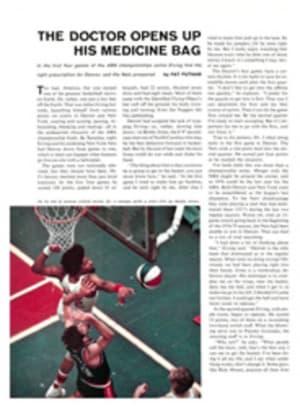
So suitable to survival
It is a spooky-looking garment: a coverall of international orange, with a hood hiding most of the face, and feet that seem designed for an elephant. Officially known as the Imperial water survival suit after its fabricator, the Imperial Manufacturing Company of Bremerton, Wash., but called the "Ugly Suit," it is catching on all over the world. It is worn on North Sea oil rigs and on Great Lakes ore carriers, aboard ice boats and helicopters carrying personnel of the Alyeska Pipeline, in over-water balloons and by Bering Sea crab fishermen. The icebreaker Manhattan carried suits for crewmen through the Northwest Passage. And it is used by winter-sailing yachtsmen, Antarctic explorers and the Military Sealift Command in the Antarctic and North Pacific.
As, cozily enveloped in an Ugly Suit, I floated in a factory testing pool under the eye of Imperial founder and president James Hill, he told me of a Coast Guardsman who shot into his office one day with hand extended. "Took a day off to shake your hand," he said to Hill. He had been pitched out of the coxswain's seat of a small surf rescue boat on a wild, dark night off the Oregon coast. Though his mates searched through the night, it wasn't until morning that he was located floating snugly in his water survival suit. He had suffered not from the 48° temperature of the walloping seas upon which he had floated lightly as a gull, he reported, but from loneliness.
This past Christmas, Foss Launch & Tug Company, the Northwest's fleet of heavy-duty tugs operating in the icy waters of the North Pacific, invested $50,000 in Imperial survival suits for its crewmen. The purchase followed the remarkable survival of five crewmen of the Crystal S. off Akutan Island in the Aleutians. That king crabber overturned and sank, but the crew had time to zip themselves into survival suits. They launched a life raft, which promptly turned turtle, but they were rescued 2½ hours later, clinging to the raft, none the worse for an experience that routinely costs lives within minutes in the bitter Bering Sea.
The current model of the survival suit, which has constantly been improved for more than a decade, is both bulky and expensive ($195 to $220 retail), and is sold only through ship chandlers. But simpler, cheaper sportsmen's models for inland boating are now undergoing tests and may be in distribution by the end of 1976.
When in full production, the company (the largest maker of wet suits of all kinds in the world) can turn out 300 survival suits a day. Some orders, escorted all the way through the line from the first cutting of 3/16" foam skin-diving-suit-type flotation rubber to final blind-stitching, have been filled in a day. It isn't the air in the suit but the material itself that floats high in the water, even when surrounding a 280-pound man. If the suit is torn or filled with water, it will not sink and the wearer stays warm, wet or dry. The suits are nylon-lined and have waterproof zippers, attached hoods, boots and gloves, and are so easy to don that it takes less than a minute to get into one ashore or on deck, three minutes in calm seas. No clothing has to be removed, not even boots—the reason for the suit's elephant feet.
Suits are made in one size to fit anyone up to 6'8" tall. "Who has time to sort through sizes in an emergency?" asks Hill. "The point is the donning time of 20 to 55 seconds. U.S. Navy tests indicate that survival time of 13 hours and more can be expected in water temperatures of 35°. We really don't know how long they'll work. We've never tested to the point of hypothermia."
Floating in the factory testing pool is an unusual experience, to say the least. As you descend into the water, air whooshes up out of the suit past your face. Nitrogen trapped in the neoprene lends such buoyancy that you cannot submerge yourself or be pushed underwater. It's even difficult to get your legs under you to climb out of the tank. A breath-inflated high-rider ring—a flotation ring attached to the suit—lifts and cushions head and neck well out of the water. I hated to get out. It was like bouncing gently on a water bed. Tacked on the tank wall is a life-size photograph of a plump girl in a mini-bikini to keep testers from falling asleep at their restful work.
The suit's major distributor in the East is Atlantic Survival of Old Harbor Road, Westport Harbor, Mass. and Adamsville, R.I. In Chicago, it is distributed by Black Industrial Supply, in Seattle by Nordby Supply. Ship chandler C. J. Hendry supplies it in San Francisco, San Pedro and San Diego. Imperial survival suits are popping up in Europe, Canada and South America; many purchasers are ship operators who know how inadequate ordinary life preservers are in cold water.
Started in a basement garage in 1959, the business has grown steadily at an annual rate of 15 to 20%. Imperial also makes reversible ski pants, jumpers and suits—a different color on each side—($60 to $120), the best idea since Willy Bogner took us out of baggy flannels.
One of Imperial's problems is what to do with scraps of flotation material that are left over after the suits are cut. If you have an idea, pass it on to Jim Hill. He hates to waste the stuff.
FOUR PHOTOS
MICKEY PFLEGER
On land and sea—or in between—the testers all praise Jim Hill (inset) for his survival suit.

